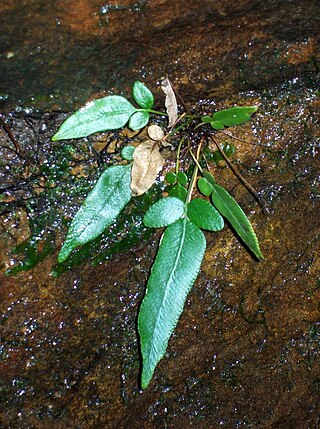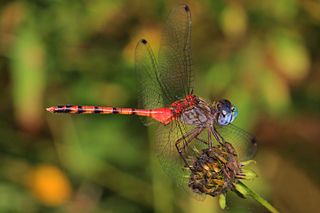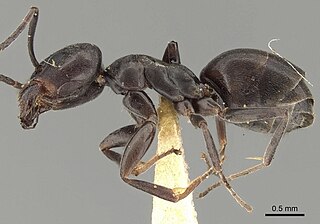
The erratic ant is a species of dolichoderine ant first described in 1789 by Latreille.

Tapinoma is a genus of ants that belongs to the subfamily Dolichoderinae. The genus currently comprises 74 described species distributed worldwide in tropical and temperate regions. Members of are generalized foragers, nesting in a wide variety of habitats, ranging from grasslands, open fields, woodlands, to inside buildings. The majority of species nest in the ground under objects such as stones or tree logs, other species build nests under bark of logs and stumps, in plant cavities, insect galls or refuse piles.
In binomial nomenclature, a nomen dubium is a scientific name that is of unknown or doubtful application.

Tapinoma sessile is a species of small ant that goes by the common names odorous house ant, sugar ant, stink ant, and coconut ant. Their colonies are polydomous and polygynous. Like many social insects, T. sessile employs complex foraging strategies, allocates food depending on environmental conditions, and engages in competition with other insects.

Tapinoma melanocephalum is a species of ant that goes by the common name ghost ant. They are recognised by their dark head and pale or translucent legs and gaster (abdomen). This colouring makes this tiny ant seem even smaller.
Eriophyllum ambiguum is a species of flowering plant in the family Asteraceae known by the common name beautiful woolly sunflower. It is native to the deserts and adjacent hills of southern and eastern California, northwestern Arizona, and southern Nevada.

Yolla Bolly bedstraw is a species of plant in the family Rubiaceae, native to British Columbia, northern California and southeastern Oregon, where it often grows on serpentine soils.

Lomatium ambiguum, also known as Wyeth biscuitroot, is a perennial herb of the family Apiaceae that grows in the northwestern United States and into British Columbia in dry areas. The leaves are divided into many blades, and stems can be slightly purple and are 6–24 cm tall. Yellow flowers in compound umbels appear from late April to June.

Parablechnum ambiguum, synonym Blechnum ambiguum, is a species of fern in the family Blechnaceae. growing on wet rocks in eastern Australia, often seen near waterfalls. It is common around Sydney.

Sympetrum ambiguum, the blue-faced meadowhawk, is a dragonfly of the family Libellulidae.
Tapinoma glaesaria is an extinct species of ant in the genus Tapinoma. Originally described by Gennady Dlussky in 2002 as Tapinoma aberrans, fossils of the species were found in the Rovno amber in Ukraine. The original specific name was a secondary homonym of Tapinoma aberrans, an extant species from Madagascar. Perrichot, Salas-Gismondi & Antoine (2019) coined a replacement name T. glaesaria for the taxon described by Dlussky.

Tapinoma israele is a species of ant in the genus Tapinoma. Described by Forel in 1904, the species is endemic to Algeria and Israel. Tapinoma israele is one of the fewest species that build Solaria during the winter.

Tapinoma nigerrimum is a species of ant in the genus Tapinoma. Described by Nylander in 1856, the species is endemic to Africa and Europe.
Tapinoma subboreale is a species of ant in the genus Tapinoma. Described by Seifert in 2012, the species is endemic to Europe.

Tapinoma wilsoni is a species of ant in the genus Tapinoma. Described by Sharaf and Aldawood in 2012, the species is endemic to Saudi Arabia.
Panicum ambiguum may refer to four different species of plants:
Eotaphrosphys is an extinct genus of bothremydid pleurodiran turtle that was discovered in the Mont Aime Formation, France. Originally assigned to the genus "Tretosternum", it consists exclusively of type species E. ambiguum.

Trifolium ambiguum, the kura clover or Caucasian clover, is a species of flowering plant in the family Fabaceae. It is native to Ukraine, Crimea, south European Russia, the northern Caucasus, eastern Turkey, Iraq, and Iran, and has been introduced to New South Wales. Planted for forage, once established it is tolerant of close grazing, and is also useful for honey production.

An ant supercolony is an exceptionally large ant colony, consisting of a high number of spatially separated but socially connected nests of a single ant species, spread over a large area without territorial borders. Supercolonies are typically polygynous, containing many egg-laying females. Workers and queens from different nests within the same supercolony can freely move among the nests, and all workers cooperate indiscriminately with each other in collecting food and care of the brood, and show no apparent mutual aggressive behavior.











